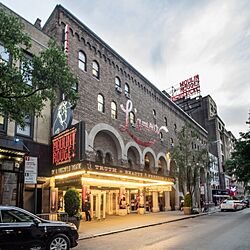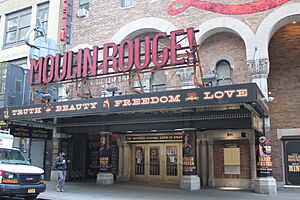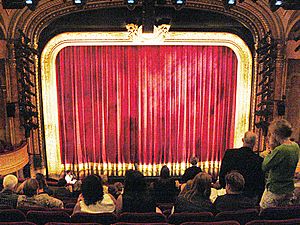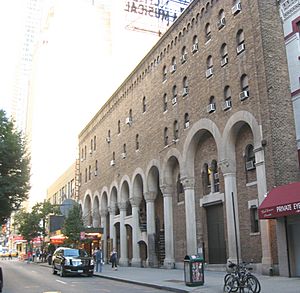Al Hirschfeld Theatre facts for kids
|
Martin Beck Theatre
|
|

The theater showing the musical Moulin Rouge! in 2019
|
|
| Address | 302 West 45th Street Manhattan, New York United States |
|---|---|
| Coordinates | 40°45′33″N 73°59′21″W / 40.7593°N 73.9892°W |
| Public transit | Subway: Times Square–42nd Street/Port Authority Bus Terminal |
| Owner | ATG Entertainment |
| Operator | ATG Entertainment |
| Type | Broadway |
| Capacity | 1,424 |
| Production | Moulin Rouge! |
| Construction | |
| Opened | November 11, 1924 |
| Years active | 1924–present |
| Architect | G. Albert Lansburgh Albert Herter (interior) |
| Designated | November 4, 1987 |
| Reference no. | 1315 |
| Designated entity | Facade |
| Designated | November 4, 1987 |
| Reference no. | 1316 |
| Designated entity | Lobby and auditorium interior |
The Al Hirschfeld Theatre is a famous Broadway theater located in New York City. It first opened in 1924 and was originally called the Martin Beck Theatre. It was built for a show business manager named Martin Beck. The theater has a unique design inspired by ancient Moorish and Byzantine styles, which makes it stand out from other theaters.
Inside, it can hold 1,424 people. The theater is so special that both its outside (the facade) and its inside are considered official New York City landmarks. This means they are protected because of their historical and artistic importance.
Over the years, the Al Hirschfeld Theatre has been home to many famous plays and musicals. Some of the biggest hits include Guys and Dolls, Into the Woods, and Kinky Boots. In 2003, the theater was renamed to honor Al Hirschfeld, a famous artist known for his drawings of Broadway stars.
Contents
A Theater with a Unique Look
The Al Hirschfeld Theatre was designed by architect G. Albert Lansburgh. He wanted it to look different from all the other theaters on Broadway. Instead of a simple design, he chose a style that looks like it came from an old, faraway land.
Outside the Theater
The front of the theater is very grand. The bottom part has a series of eleven tall arches supported by stone columns. This row of arches is called an arcade. The columns have detailed carvings inspired by historical designs from Spain and the Middle East.
The main entrance is under three of these arches on the right side. Above the entrance, a large sign, called a marquee, hangs over the sidewalk to show what play is currently running. The upper parts of the building are made of red brick, with more arched windows that match the style below.
Inside the Theater
The inside of the theater is just as fancy as the outside. The artist Albert Herter designed the decorations to make visitors feel like they were in a palace.
Lobbies and Lounges
When you first walk in, you enter a small ticket lobby with a beautiful arched ceiling made of special tiles. From there, you go into the main inner lobby, which is very tall and has three colorful domes on its ceiling. The walls are decorated with fancy plasterwork and iron light fixtures.
There is also a comfortable lounge for people to relax in before the show or during intermission. It has a unique L-shape and is decorated with the same care as the rest of the theater.
The Auditorium
The auditorium, where the audience sits, is decorated in rich colors like red, blue, and orange, with touches of gold. The space is divided into the main floor, called the orchestra, and an upper level called the mezzanine.
On the sides of the stage are special seating areas called boxes. These boxes have fancy columns and curved ceilings that look like fans. The main ceiling of the auditorium is an octagon with a huge, colorful wooden dome in the center. A beautiful glass chandelier hangs from the middle of the dome, lighting up the whole room.
The large arch around the stage is called the proscenium. It is decorated with four layers of arches and columns, each with a different design. This beautiful frame makes the action on stage feel even more magical.
History of the Theater
The theater has a long and interesting history, starting in the exciting era of the 1920s in New York City.
The Martin Beck Years
In the 1920s, the theater district around Times Square was growing quickly. Martin Beck, a successful vaudeville show manager, wanted to build his own theater. He bought several houses on West 45th Street and built a grand new venue. The Martin Beck Theatre opened on November 11, 1924. It was special because Beck owned it completely, without any loans.
In its early years, the theater hosted many different kinds of shows. The famous Theatre Guild used the theater for many of its plays. Famous actors like Katharine Hepburn, Alfred Lunt, and Lynn Fontanne performed on its stage.
After Martin Beck's death in 1940, his wife Louise managed the theater. It continued to host major hits. One of the most successful was The Teahouse of the August Moon, which ran for over 1,000 performances in the 1950s. Another big hit was the musical Bye Bye Birdie in 1960.
A New Name and New Shows
In 1966, the theater was sold to Jujamcyn Theaters, a major Broadway theater owner. Under its new owners, the theater continued to present important shows. In 1977, a popular new version of Dracula starring Frank Langella was a huge success.
The 1980s brought more hits, including Stephen Sondheim's famous musical Into the Woods in 1987. In 1992, a revival of the classic musical Guys and Dolls was a big success and ran for three years.
In 1987, New York City officially made the theater a landmark. This protected its beautiful design for future generations to enjoy.
Becoming the Al Hirschfeld Theatre
In 2003, Jujamcyn decided to rename the theater to honor Al Hirschfeld on his 100th birthday. Hirschfeld was a beloved artist who had spent decades drawing famous actors and scenes from Broadway shows. He was famous for hiding the name of his daughter, Nina, in his drawings.
Sadly, Hirschfeld passed away just before the official renaming ceremony. The theater was given a new marquee featuring a self-portrait of Hirschfeld as an inkwell. Inside, the lounge was decorated with 22 of his famous drawings.
Recent Hits
The newly named Al Hirschfeld Theatre opened in 2003 with the musical Wonderful Town. Since then, it has been home to many popular shows.
The musical Kinky Boots opened in 2013 and was a massive hit, running for over 2,500 performances. In 2019, the spectacular musical Moulin Rouge! opened. It became one of the most successful shows in the theater's history, breaking box office records. After a temporary closure in 2020, the show reopened in 2021 and continues to be a top attraction on Broadway.
Famous Shows at the Hirschfeld
Over its long history, the theater has hosted hundreds of productions. Here are some of the most famous ones.
As the Martin Beck Theatre
- The Shanghai Gesture (1926)
- The Barretts of Wimpole Street (1935)
- Saint Joan (1936)
- Watch on the Rhine (1941)
- The Iceman Cometh (1946)
- The Rose Tattoo (1951)
- The Crucible (1953)
- The Teahouse of the August Moon (1953)
- Sweet Bird of Youth (1959)
- Bye Bye Birdie (1960)
- Man of La Mancha (1968)
- Dracula (1977)
- Into the Woods (1987)
- Guys and Dolls (1992)
- The Sound of Music (1998)
- Kiss Me, Kate (1999)
As the Al Hirschfeld Theatre
- Wonderful Town (2003)
- Hair (2009)
- How to Succeed in Business Without Really Trying (2011)
- Kinky Boots (2013)
- Moulin Rouge! (2019)
See also
- List of New York City Designated Landmarks in Manhattan from 14th to 59th Streets
- List of Broadway theaters






